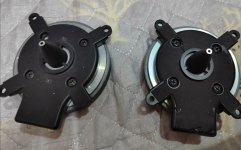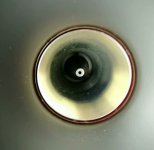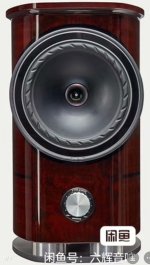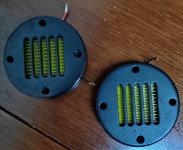Any and all comers are welcome! When I was designing automotive coaxes, it was hard to get those flat as well. Probably reflection off the center post/tweeter bridge, I never had time to really investigate. And as @Patrick Bateman somewhat alludes, there would always always be a phasing problem where with a single Capacitor Cro$$over (spelled with a C for "CHEAP") there would be a peak and dip. Changing the capacitor value moved this around but it could really only be ameliorated with a 12 dB highpass. (But Patrick what do you mean by "behind" the woofer? You mean like compression driver coaxials with non-DSP crossovers?)I am assuming that by coaxial, this thread is about the tweeter fitted where the dust cap or phase plug would normally be? And not include tweeters sitting on a stem at the same location?
I haven't seen any responses for these types of speakers, probably because DIY models aren't like that (???) and aftermarket automotive companies aren't providing such.
Actually to misquote Diogenes I should have said in the original post "I'm looking for a smooth coaxial!"
Yes, and when used as mid/tweeters the coaxial problem of the moving woofer position modulating the tweeter response should be vastly reduced. However those drivers aren't for regular sale (maybe as service parts??). And actually we don't know what the raw response looks like, just the post-crossover. But those Uni-Q are one reason I ask the question, if they seemingly can do it then what is this seeming sh!te others are trying to sell us at high prices?Kef also seem to have gotten fairly close with their UNI Q
REW (http://roomeqwizard.com) freeware + a UMIK (https://www.minidsp.com/products/acoustic-measurement/umik-1), I don't know who distributes that Down Under. Hey does anyone down there make Vegemite cones? (I'm innocent! Blame Men At Work!). This thread was actually spurred from thinking about your thread about the Phoenix Gold vs Pioneer.The Phoenix Gold MX6.5 coaxial unit made for car audio...They don’t show a graph but how do I measure one?
That would go some ways to explain why my Pioneers sounded better than any coax that I have ever heard, now you are making me double think on those MX6.5s vs another set of PioneersI've had a few projects that weren't received with much fanfare, but which worked really great.
My coax design was one:
https://www.diyaudio.com/community/threads/synergy-eggstravaganza.309095/post-5110101
Based on everything I've seen, I really and truly think that tweeters don't really have a place behind the woofer. At least not in a 'true' coaxial, where the woofer and tweeter are one unit.
In a nutshell, it's far easier to get good results if you just put the tweeter on a 'bridge', like cheap car coaxials do.
As you've found in your research, when you put the tweeter inside the voice coil, or even worse, behind the woofer, the response curve just looks awful.
Putting the tweeter in front of the woofer creates an issue, but it's an issue that is fixable. Whereas, the crummy high frequency response of a tweeter in the throat of a woofer is NOT fixable.
So, the issue you get with the tweeter in front of the woofer is that the output of the tweeter will "lead" the woofer by about 0.25-0.5 milliseconds. The actual delay depends on the distance and the crossover, so it's a tricky one to solve. If you go fully active, it's incredibly simple to fix, just use DSP delay on the tweeter. If you're going passive, things get trickier; you want to get the tweeter about one half to one full wavelength ahead of the woofer, and then flip the polarity of one driver in the former case, or keep the polarity the same in the latter case.
That paragraph is probably confusing, but you can sim all of this with Vituixcad.
I imagine that a lot of people think that car coaxials sound bad because they didn't like how they sounded, but the truth is that it's mostly a crossover problem. Fundamentally, you're going to get better frequency response if you take that tweeter out of the woofer's throat and put it on a bridge in front of the woofer. The woofer can't "see" the bridge because it's too small, acoustically. But when the tweeter is in the throat of the woofer, it can definitely see it.
Years ago, the late great Audio Critic magazine heaped praise on a very pedestrian looking speaker that was built like this, and at the time, I remember thinking it looked like a cheap car audio coax in a monkey coffin. But in hindsight, I think the designer had the right idea.
Any and all comers are welcome!
TS-D65F
This sounds sweeter on the sound board than any audition I have ever done in a shop. Car audio or Hi-fi. Cannot fault any part of any track and since the owner is a friend, I have spent a lot of time going through many tracks. I bought a pair that I have sine used in my car after only auditioning with 70s and 80s dub. Recently, have spent a few hours trying all sorts of track. I'll take them out of the car and AB against the Pheonix Golds if I decide to order them tonightBugger, I bought the wrong mic then. Would is still be possible to use the Behringer calibrated mic with XLR? Vege cones are very popular hereREW (http://roomeqwizard.com) freeware + a UMIK (https://www.minidsp.com/products/acoustic-measurement/umik-1), I don't know who distributes that Down Under. Hey does anyone down there make Vegemite cones? (I'm innocent! Blame Men At Work!). This thread was actually spurred from thinking about your thread about the Phoenix Gold vs Pioneer.
Lol, I put the drivers in the car just because of the stem thingy, thinking why aren't the $1k hi-fi drivers using a stem. Thank you @Patrick Bateman for setting the record straight on this feature
Bi-amping would mean that my amp modules inside the sub wouldn't be enough channels. I need two more for the tweeters. I have to take out the driver and see if the stock xover can be easily bypassed
Pioneer has always had some type of decent car audio coax available, even if the crossover was compromised by cheap component quality. Ive owned a few of these and have managed to get decent sound from them, provided you fix the crossover issue with better HP caps and a real air cored series LP inductor. The other glaring issue is the need for time alignment (delay) of the tweeter element if you had a biamp capable coax.
Yes of course, just need a USB interface like Focusrite Scarlett 2i2 or similar. Then you will have perfect loudspeaker measuring equipment.Bugger, I bought the wrong mic then. Would is still be possible to use the Behringer calibrated mic with XLR?
Fascinating thread. Well I'm just getting my toes wet with a set of Tannoy Precision 8 coax+woof ($270 scrounged from three places) and the 19mm Mg-dome compression tweeters from Fyne F1-5 ($70 due to a broken leg).Secondly, for maximum sound quality, a coaxial driver should never be made to play any kind of bass. If it moves past maybe 0,5mm, it should be so loud that distortion is becoming hard to hear. Typically, a 6,5 inch coaxial should not be used below say 250Hz without significant asistance. This also paves way for some different strategies when it comes to suspension.
Because making the interfacing between the cones and the surrounding parts is important. When manufacturers do the common thing, taking a woofer, and adding a tweeter to it, then nothing was really made to work well as a coaxial driver to begin with. If we look at the dispersion of the midrange at the cross over point, it depends on the size, shape, material and the position of the voice coil. The voice coil is normally centered, but often larger than ideal. A 39mm voice coil is common with a 26mm dome. This leaves a significant gap that does not produce sound. The angle and profile of the cone really determines how effective it is as a waveguide, but also its own natural dispersion.
The P8 coax spec'ed 5ohm and 1.8khz 2nd-order LP, 1st-order HP; from a picture I quickly reverse-engineered & tweaked the XO and found only the coax bass a bit wanting, in my 17L TLonken (~42hz tapered MLTL). Per above recommendation, I ought to high-pass the coax and use the matching woofer for bass. Will try.
My plan for the odd-looking Fyne F1-5 compression needle-stalk is to fashion a tulip waveguide just from pictures (not likely to spend $5K to impress a mold!). Big gap indeed.
I have 15" Echotech (flat to 4.3khz) and 12" alnico Fostex W300Aii (flat to 2.6khz) both useable straight-through (following JohnK). I have tried the 15" with 35mm-casing, plast-tape waveguided ceramic-dome car tweeter on a "bridge"; next up will be doubled AMT from desktop Eve Audio SC203 (just 40mm round 10mm thick; couldn't resist $40/2pr). My pairing for the 12" is vintage "bigbutt" cone tweeter not coax-mounted, but maybe something or other will work coax.
Suggestions are welcome and appreciated.
It is quite easy to align phase physically at the XO frequency by playing a test tone and moving the tweeter back-and-forth to determine max/min combined volume. But this isn't as good as aligning the acoustic centers (plus phase at XO frequency).
Attachments
Last edited:
When and where the proportional sizes of the drivers makes sense, I totally agree with you Patrick……larger woofers 8,10,12”…..the diffraction caused by the protruded tweeter or it’s mount is manageable and the more equitable design choice IMO.I've had a few projects that weren't received with much fanfare, but which worked really great.
My coax design was one:
https://www.diyaudio.com/community/threads/synergy-eggstravaganza.309095/post-5110101
Based on everything I've seen, I really and truly think that tweeters don't really have a place behind the woofer. At least not in a 'true' coaxial, where the woofer and tweeter are one unit.
In a nutshell, it's far easier to get good results if you just put the tweeter on a 'bridge', like cheap car coaxials do.
As you've found in your research, when you put the tweeter inside the voice coil, or even worse, behind the woofer, the response curve just looks awful.
Putting the tweeter in front of the woofer creates an issue, but it's an issue that is fixable. Whereas, the crummy high frequency response of a tweeter in the throat of a woofer is NOT fixable.
So, the issue you get with the tweeter in front of the woofer is that the output of the tweeter will "lead" the woofer by about 0.25-0.5 milliseconds. The actual delay depends on the distance and the crossover, so it's a tricky one to solve. If you go fully active, it's incredibly simple to fix, just use DSP delay on the tweeter. If you're going passive, things get trickier; you want to get the tweeter about one half to one full wavelength ahead of the woofer, and then flip the polarity of one driver in the former case, or keep the polarity the same in the latter case.
That paragraph is probably confusing, but you can sim all of this with Vituixcad.
I imagine that a lot of people think that car coaxials sound bad because they didn't like how they sounded, but the truth is that it's mostly a crossover problem. Fundamentally, you're going to get better frequency response if you take that tweeter out of the woofer's throat and put it on a bridge in front of the woofer. The woofer can't "see" the bridge because it's too small, acoustically. But when the tweeter is in the throat of the woofer, it can definitely see it.
Years ago, the late great Audio Critic magazine heaped praise on a very pedestrian looking speaker that was built like this, and at the time, I remember thinking it looked like a cheap car audio coax in a monkey coffin. But in hindsight, I think the designer had the right idea.
I wonder if the differing radiation patterns of using a planar tweeter or mid tweeter would be worth the effort. Or what about a 15” woofer with a small egg shape baffle in the middle supporting a 2” dome mid and a 19mm dome tweeter?
I might do these as 3-way active speakers, with the sub drivers in the same cab as built in stands, i.e. if the stock xover can be bypassed. The pioneer drivers sound sweet enough to warrant a lot of effort. Maybe I shouldn't drive this thread off-topic with my buildPioneer has always had some type of decent car audio coax available, even if the crossover was compromised by cheap component quality. Ive owned a few of these and have managed to get decent sound from them, provided you fix the crossover issue with better HP caps and a real air cored series LP inductor. The other glaring issue is the need for time alignment (delay) of the tweeter element if you had a biamp capable coax.
Coffee break philosophy:
Problem is with wavelength, like always 😀 Which changes dramatically from lows to highs. In a coaxial system both ways (mid and tweet) are basically the same physical object, and the object is static in size, while wavelength varies a lot within the pass band. More over there is a crossover, where there is two sound sources at different locations on the object and are of different in size, who both output sound at same wavelength, they just cannot be the same. Well, they don't necessarily need to be the same, but they are still the immediate acoustic environment for each other so they would need to play themselves but also together for each other.
Either both woofer and tweeter would need to be physically optimized to be good acoustic environment for whole bandwidth which defeats the whole point of a coaxial (it would be a single transducer), or optimized for their own bandwidth, or by compromise optimized for both bandwidths. It would be cool if there was a cone material that would be optimal for woofer resonances in mind while simultaneously be in a shape of "optimal" waveguide for tweeter, not sure if possible. Perhaps there is some fine nice set of compromises it comes together, but is it then just the ticket for your application, for example directivity wise?
To reduce the problems I would think that both the tweeter and woofer need to be as close in size as possible and cover small bandwidth (from total system bandwidth) in order to somewhat reduce issues, which again somewhat defeats the whole purpose. So, if it's coaxial, there are some compromises, and if those suit (sound) better than some other kind of speaker system then it's better set of compromises and just accept there is some wiggle here and there, does it matter if it still sounds best? So, better look into psychoacoustics and room / application at hand and figure out if a coaxial is fine, or perhaps something else, and just go with what makes best end result and not worry too much about some details that would be better on some other situation. This is like being jealous for something, longing something you don't have while there is really no need to. If it needs to be coaxial, pick the one that suits best.
Problem is with wavelength, like always 😀 Which changes dramatically from lows to highs. In a coaxial system both ways (mid and tweet) are basically the same physical object, and the object is static in size, while wavelength varies a lot within the pass band. More over there is a crossover, where there is two sound sources at different locations on the object and are of different in size, who both output sound at same wavelength, they just cannot be the same. Well, they don't necessarily need to be the same, but they are still the immediate acoustic environment for each other so they would need to play themselves but also together for each other.
Either both woofer and tweeter would need to be physically optimized to be good acoustic environment for whole bandwidth which defeats the whole point of a coaxial (it would be a single transducer), or optimized for their own bandwidth, or by compromise optimized for both bandwidths. It would be cool if there was a cone material that would be optimal for woofer resonances in mind while simultaneously be in a shape of "optimal" waveguide for tweeter, not sure if possible. Perhaps there is some fine nice set of compromises it comes together, but is it then just the ticket for your application, for example directivity wise?
To reduce the problems I would think that both the tweeter and woofer need to be as close in size as possible and cover small bandwidth (from total system bandwidth) in order to somewhat reduce issues, which again somewhat defeats the whole purpose. So, if it's coaxial, there are some compromises, and if those suit (sound) better than some other kind of speaker system then it's better set of compromises and just accept there is some wiggle here and there, does it matter if it still sounds best? So, better look into psychoacoustics and room / application at hand and figure out if a coaxial is fine, or perhaps something else, and just go with what makes best end result and not worry too much about some details that would be better on some other situation. This is like being jealous for something, longing something you don't have while there is really no need to. If it needs to be coaxial, pick the one that suits best.
Last edited:
I think I can make a cone like this using a few different methods. Foam sandwich with carbon fibre skins would be easy on my equipment for a total depth of 40mm. Anybody want to turn that into a coax?It would be cool if there was a cone material that would be optimal for woofer resonances in mind while simultaneously be in a shape of "optimal" waveguide for tweeter, not sure if possible
Would there be any point to making a foam overlay that sticks onto an existing cone, skinned over or unskinned. Skin materials can be carbon fibre, paper, plastic, glass, foil
I spent too many years working composites that folks used to maim and release fish in the name of sport and prize money 🙁Do you make cones @Randy Bassinga ?
I make my own Guitar speakers and now that powerful small neo speakers are available, mumbling about making a small unobtrusive dome tweeter to be mounted on an aluminum pole screwed into the pole piece.
Reasonably doable.
Not a full driver and horn as in Tannoy, that is beyond my capabilities.
Such tweeters can be bought to assemble car type speakers, but quality is abysmal so DIY is the way to go.
Reasonably doable.
Not a full driver and horn as in Tannoy, that is beyond my capabilities.
Such tweeters can be bought to assemble car type speakers, but quality is abysmal so DIY is the way to go.
Would there be any point to making a foam overlay that sticks onto an existing cone, skinned over or unskinned. Skin materials can be carbon fibre, paper, plastic, glass, foil
For midrange applications, adding loss is not desirable. Improving stiffness, reducing the mass of coil and suspension etc, improving shape and controlling the relationship between mass and damping in the surround are far better ways to improve the midrange response.
I spent too many years working composites that folks used to maim and release fish in the name of sport and prize money 🙁
Vacuum infusion or prepreg?
Here you go...Specially now with neo magnets reducing size and mounting area of tweeters.
Seem rather easy to just mount traditionally tweeter in front of a woofer
with a mounting bar/bridge
http://www.ase-scanspeak.de/ase-chassis.html
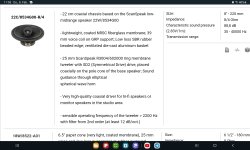
Danley makes synergy horns from small coax drivers of the kind that have a waveguide where a dustcap would otherwise be fitted. He seals off the space between the woofer cone and the waveguide and then drills holes into the waveguide for the bass to enter it. First, he replaces the waveguide with a better one, no doubt with an optimized throat and a decent mouth termination. This seems quite DIYable with ATH and 3D printing and perhaps one of the better ways of modifying a coax for hifi.
@perrymarshall has been making open baffle speakers with coax drivers at the top that are highly regarded. His threads identify several coax drivers worth their cost. DSP eq is key to flattening the top end.
@airvoid pointed out that the BMS 12C362 has a very smooth integration between compression driver throat and woofer cone and thus one of the smoother top ends available.
@perrymarshall has been making open baffle speakers with coax drivers at the top that are highly regarded. His threads identify several coax drivers worth their cost. DSP eq is key to flattening the top end.
@airvoid pointed out that the BMS 12C362 has a very smooth integration between compression driver throat and woofer cone and thus one of the smoother top ends available.
I meant a wave guide shaped overlay in XPS foam. The weight penalty would be negligible, stiffness would be significantly increasedFor midrange applications, adding loss is not desirable. Improving stiffness, reducing the mass of coil and suspension etc, improving shape and controlling the relationship between mass and damping in the surround are far better ways to improve the midrange response.
Infusion and hand lamination in my workshops and outsourcing to Korea to a master of working Toray prepregs. I would use infusion for a homemade cone or overlay to get as much epoxy out as I can. I can also do an alloy or composite basket or bridgeVacuum infusion or prepreg?
Just had another white whale drop pon me, a FR driver carrying down to female vocal range and crossing over to a woofer in a coaxial config, this is a two headed whale with a 2" FR and 7" woofer as one whale and
Dual concentric carbon fibre or paper and foam sandwich structures with an exciter in the centre under the "tweeter" and a ring of exciters behind the "woofer". I should be able to find off the shelf roll surrounds in PRC. Modelling and making all the parts is easily within the means of my current lil workshop. Knowing what shapes to make is not
- Home
- Loudspeakers
- Multi-Way
- what is the point of expensive coaxials with ragged response?
